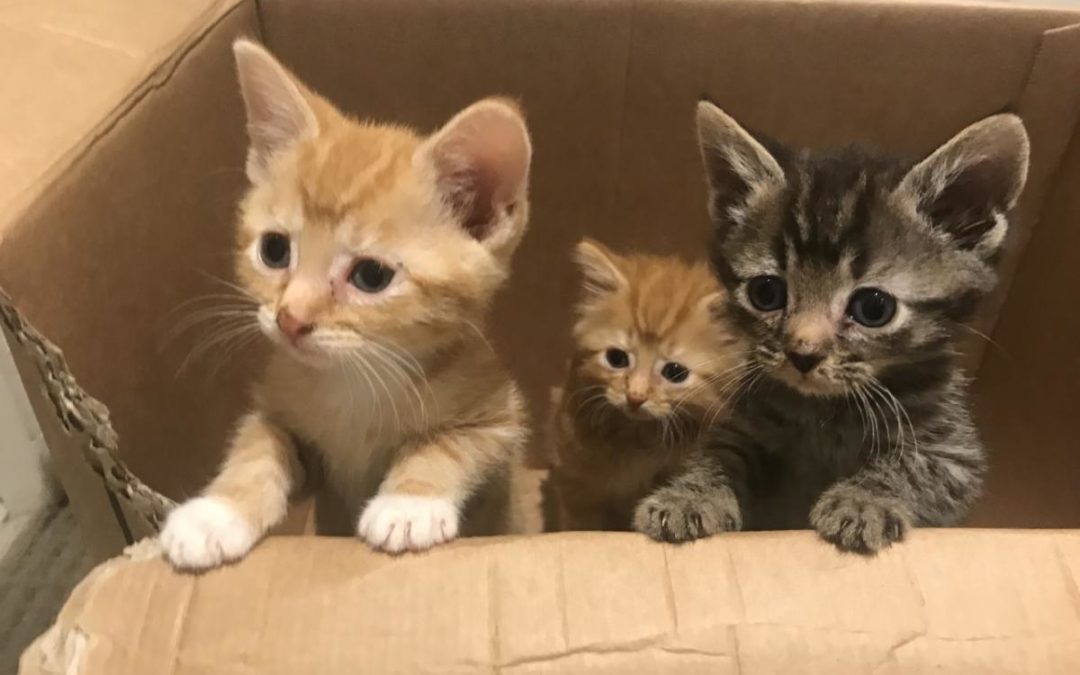
What To Do If You Find Kittens
In a recent blog post, we discussed “kitten season,” the time of year when the kitten population seems to explode and can be extremely overwhelming for rescues and shelters alike. Because we are right in the middle of kitten season now, we wanted to expand on what you should do if you find kittens.
You may be tempted to gather them up and bring them into your home, but sometimes, this can cause more harm than good. If you find a kindle (did you know that’s the name for a group of kittens?), here are some tips to keep in mind.
A Kitten Is Safest With Their Mom
Your instinct will likely be to bring the kitten(s) indoors, but kittens are definitely safest with their mom. For health reasons, if you find a mom and her kittens, please leave them be but keep an eye on them. Create a safe, comfortable haven for the mother cat to take care of her babies, and this should include warm bedding, as kittens require a tremendous amount of warmth.
Be sure to put out clean water and change it frequently, and both wet and dry kitten food is best so the mama cat can keep up her caloric intake while feeding the babies.
What About Kittens Without Their Mom?
It’s pretty common to come across kittens and the mother is nowhere to be found. If this happens to you, leave the kittens where they are, but plan to observe them every two to three hours to see if the mother cat materializes. This advice pertains to kittens who appear to be in good health, and are free from any obvious illnesses or suffering. If you do see the mother cat, leave the kittens alone and contact a local rescue to let them know what you have found. They can assist with safely trapping the family and providing them with the care they need.
What If The Mom Is Absent After 2-3 Hours?
If you have found a newborn kitten (even if their eyes are closed and the umbilical cord is still attached), wait a couple of hours to see if the mom returns. She may be busy finding food or relocating her litter, and you may have stumbled upon the lone kitten in the interim. However, if the mom is still absent after two or three hours, take the kitten(s) to safety.
Keeping a Kitten Warm Is Your #1 Priority
Your first priority should be to keep the kitten warm or to help them regain a normal body temperature before you do anything else. This can be achieved by placing the kitten inside your shirt or creating a soft, warm environment inside a crate or carrier for them in your home. Fleece blankets are particularly effective, as are warming blankets and hot water bottles, but make sure to cover any warming objects to avoid burns. You are looking for a temperature of about 90F. A nearby heater is also a good idea.
Try To Help The Kitten Go Potty
After the kitten has regained their temperature, they will likely be more active and moving around. This is a good indication that you should feed them. But, before you do, help the kitten go potty by helping to stimulate them. Rub a paper towel on their genital and anal area, as kittens require assistance and can’t go potty on their own. Usually, their moms will help them with their tongues, so you don’t have to be super gentle. But know that this takes patience and practice, so don’t give up! They also may not have been fed for some time, and they naturally don’t have to go.
Feeding Time
Once you’re ready to feed the kitten, be sure that you have Kitten Meal Replacement (KMR) formula at the ready. The only suitable alternative is goat’s milk. Cow’s milk is not tolerated well by kittens and could cause them to have diarrhea and dehydration. You will need a kitten bottle, and you should follow the instructions on how to warm up the formula prior to feeding. Make sure you check the temperature before you feed, exactly as you would with a baby. Newborn kittens will need to eat every two hours if their eyes are closed, and every four hours if their eyes have opened.
Determining the Needs of a Kitten
A good rule of thumb is that if a kitten can walk on their own, they do not need to be kept warm as we discussed above. However, they can still be given warm formula if they are showing signs of hunger. Put down a saucer of formula to see if they will lap it up on their own, but you may need to feed them with a bottle too. Depending on their age, they may also be interested in dry kibble or wet food too. Be sure that water and food are available at all times for any kittens you take in. Also, kittens who can walk on their own will need a litter box to use, and you should use a soft litter for their sensitive paws.
Other Considerations
Keep in mind that many kittens who are in need of help will look for it and come to you. But others may be frightened and scared, hissing and spitting as you’re attempting to help them. Use a blanket, a towel, or gloves to assist you in handling the kitten if they are being a bit wild. Holding them close to your heart where they can feel it beating will help to calm them down. Be on the lookout for any signs of diarrhea that persist for 24 hours after you have started feeding. If you find this, it would be best to contact a veterinarian or rescue who can help you.
If you’re interested in adopting, fostering, or volunteering with Paw Prints In The Sand animal rescue, please reach out to us at info@pawprintsinthesand.org. We appreciate your ongoing support!
Author profile:
Kyle Colton is a freelance copywriter, flight attendant, and pet mom to Henri (a 13-year-old Landseer Newfoundland), Pearl (a 5-year-old PPITS alum kitty), and Ruby (a 2-year-old rescue kitty).






Recent Comments